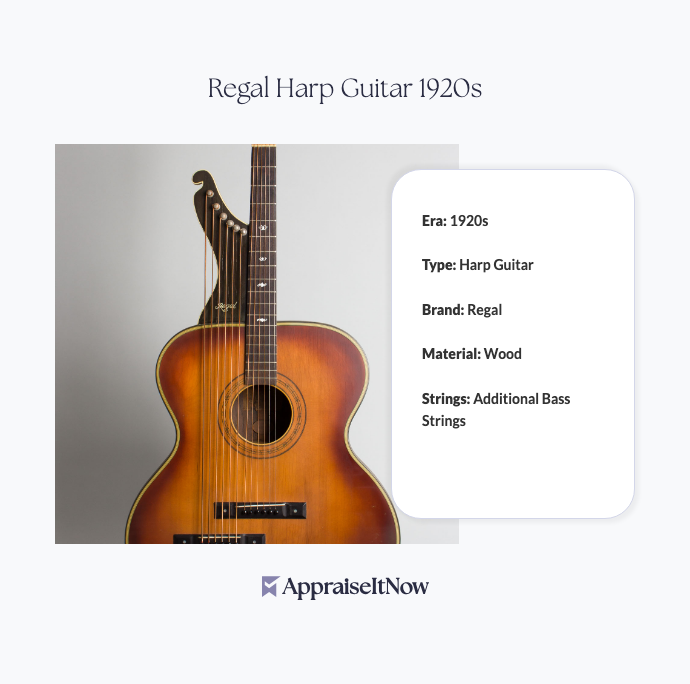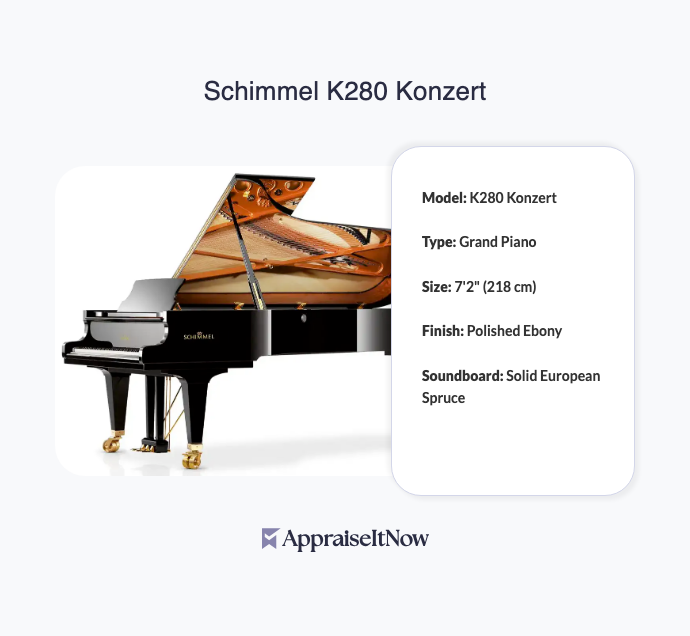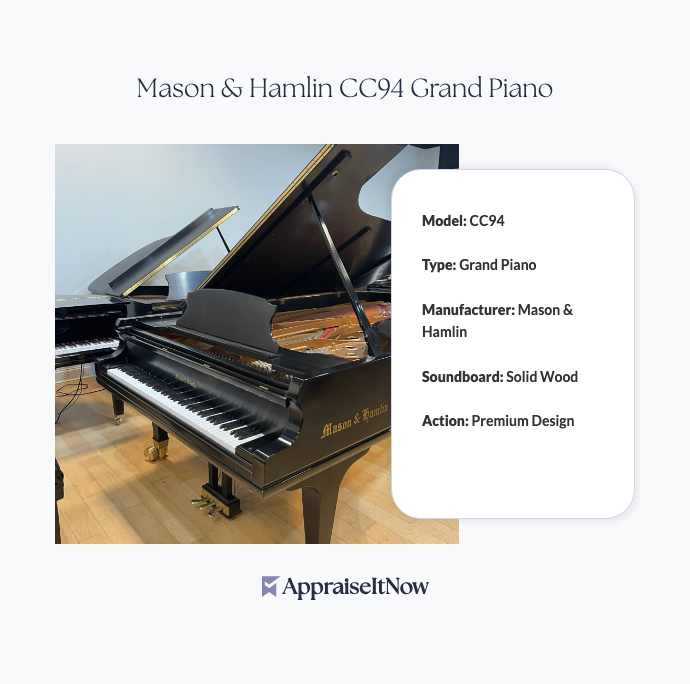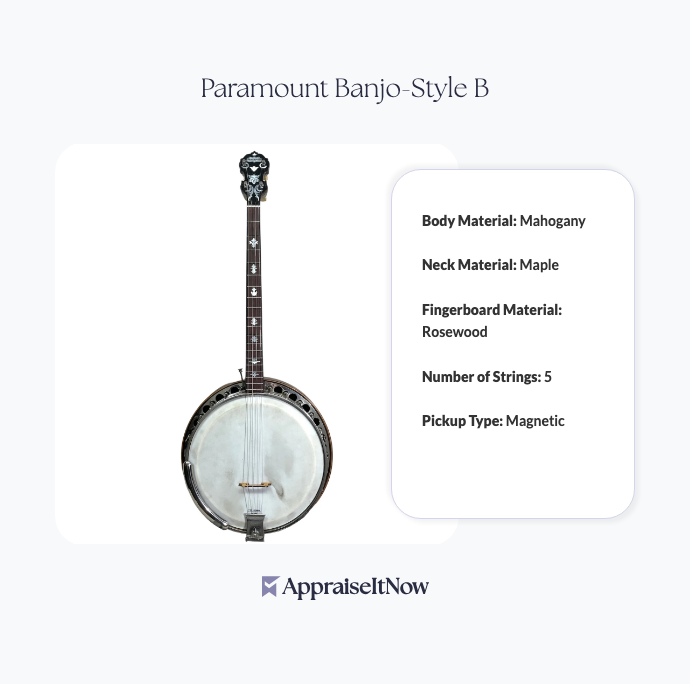<h1>How to Get Your Regal Harp Guitar 1920s Appraised</h1>
<p>The Regal Harp Guitar from the 1920s stands as one of the most distinctive and valuable instruments in the vintage guitar market, commanding prices between <strong>$3,000 and $5,000</strong> for quality examples. If you own one of these exceptional instruments or are considering acquiring one, understanding how to properly appraise this unique harp guitar is essential for making informed decisions about buying, selling, insurance, or collection management.</p>
<h2>Understanding Your Regal Harp Guitar's Value</h2>
<p>The Regal Harp Guitar represents far more than just a stringed instrument—it's a piece of musical history that combines innovative engineering with exceptional craftsmanship. First introduced in <strong>1920</strong>, this model emerged during a remarkable period of American guitar manufacturing when makers experimented boldly with instrument design and sound possibilities.</p>
<p>What makes your Regal Harp Guitar particularly valuable? Its distinctive harp-like design with additional bass strings creates an expanded tonal range that professional musicians and serious collectors prize. Unlike conventional guitars, the harp guitar's parallel bass strings extend beyond the traditional fretboard, allowing for open resonance and harmonic possibilities that standard instruments cannot achieve. This technical innovation, combined with limited production runs, has made authentic Regal Harp Guitars highly sought-after assets in today's <a href="/types/memorabilia-and-collectibles">memorabilia and collectibles</a> market.</p>
<div class="callout tip"><p><strong>Collector's Insight</strong></p>
<p>Regal Harp Guitars with documented professional musician ownership or recording history can command premiums of 15-25% above standard market values.</p></div>
<h2>Key Features That Define Your Regal Harp Guitar</h2>
<p>Understanding the specific characteristics of your instrument helps establish its proper market value. The exceptional craftsmanship evident in Regal instruments from this era reflects the company's commitment to quality during a golden age of American guitar manufacturing.</p>
<p>The harp guitar's most defining feature is its parallel bass string array, typically numbering between 6 and 12 additional strings running outside the main fretboard. These sub-bass strings produce rich, resonant tones ideal for fingerstyle playing and contribute significantly to the instrument's aesthetic and acoustic appeal. Your Regal model likely features solid wood construction with careful attention to detail in bracing patterns, wood selection, and hardware finishing that characterizes pre-1930s quality guitar manufacturing.</p>
<p>Condition directly impacts your harp guitar's appraisal value. Authentic examples from the 1920s should display appropriate aging, patina, and wear consistent with decade-old instruments. However, structural integrity remains paramount—cracks in the top or back, loose bracing, or damaged bass string anchors substantially reduce value. The original finish, even if faded or worn, typically commands higher prices than refinished examples among discerning collectors of <a href="/types/antique-furniture">antique furniture</a> and musical instruments.</p>
<h2>Why Professional Appraisal Matters for Your Harp Guitar</h2>
<p>Determining accurate value for a 1920s Regal Harp Guitar requires specialized expertise that goes beyond general guitar knowledge. The harp guitar market differs significantly from standard acoustic guitar valuation because fewer appraisers possess detailed knowledge of this specific instrument category. Professional appraisers specializing in <a href="/blog/assessing-the-value-of-musical-instruments-appraisals-of-vintage-guitars-pianos-and-violins">vintage guitars and musical instruments</a> bring critical competencies to the evaluation process.</p>
<p>Your appraiser should conduct a comprehensive inspection examining construction details, wood species identification, hardware originality, and structural soundness. They'll assess whether your Regal represents an early production run (more valuable) or later manufacture within the 1920s decade. Authentication becomes crucial because harp guitar replicas and modern reproductions exist, and distinguishing genuine 1920s Regal instruments from later imitations requires trained expertise.</p>
<div class="callout note"><p><strong>Professional Consideration</strong></p>
<p>USPAP-compliant appraisals from certified experts provide documentation acceptable for insurance claims, estate settlements, and legal proceedings—essential protection for valuable musical instruments.</p></div>
<h2>Factors That Influence Your Regal Harp Guitar's Market Value</h2>
<p>Several interconnected factors determine where your specific instrument falls within the <strong>$3,000-$5,000</strong> valuation range. The rarity factor plays a significant role—Regal's limited production runs mean each surviving harp guitar represents a scarce example from the original manufacturing era. Fewer instruments produced means higher baseline scarcity value, particularly for models that saw minimal distribution outside major urban music centers.</p>
<p>Your instrument's documented playing history or professional musician associations significantly enhance its worth. Harp guitars played by renowned musicians or featured in period recordings command substantial premiums. Similarly, examples with clear provenance documentation—original sales records, maker's marks, or verifiable ownership chains—attract higher valuations. The question of whether your harp guitar was actually played or remained primarily a collector's piece influences buyer demand and market positioning.</p>
<p>The condition of the original hardware, tuning mechanisms, and bridge construction matters considerably. Original Regal hardware with maker stamps generally indicates authentic period manufacture and prevents concerns about later replacements or reproduction components. Conversely, replaced tuning pegs, modified bass string anchors, or reconstructed bridges can reduce value by 20-30% depending on the extent of modifications and quality of replacements.</p>
<p>Aesthetic appeal extends your harp guitar's market reach beyond purely functional musicians. Collectors of <a href="/types/antique-artwork">antique artwork</a> and decorative musical instruments value the visual impact of an instrument's wood grain, finish quality, and overall presentation. A visually striking example with beautiful figuring in the spruce top or back wood attracts broader collector interest and supports higher valuations.</p>
<h2>Identifying Your Regal Guitar and Authenticating Its Origin</h2>
<p>How do you identify a Regal guitar authentically? Examining maker's marks provides the first verification step. Genuine Regal instruments display clear headstock logos and body badges indicating "Regal" manufacture, typically stamped or inlaid during the manufacturing process. The 1920s production period shows consistent badge designs that differ from later Regal models, allowing experienced appraisers to confirm production era.</p>
<p>Serial numbers, when present and legible, offer additional authentication evidence. Regal's numbering systems evolved throughout the 1920s, and documented serial number ranges help confirm whether your instrument falls within the correct production period. However, serial numbers alone don't guarantee authenticity—appraisers must evaluate these against other construction characteristics and manufacturing techniques specific to genuine 1920s Regal instruments.</p>
<p>Construction details reveal valuable information about your harp guitar's authenticity and manufacture date. The types of wood selected, bracing patterns, binding materials, and hardware attachment methods all reflect manufacturing standards and cost-control decisions specific to particular production years. Comparing your instrument against documented examples of verified Regal Harp Guitars helps confirm whether all construction elements align with authentic period manufacture.</p>
<div class="callout tip"><p><strong>Authentication Protocol</strong></p>
<p>Professional appraisers photograph and document all identifying marks, serial numbers, and construction details as part of the appraisal process, creating verifiable records that protect your ownership and support future valuations.</p></div>
<h2>The Role of Condition in Your Harp Guitar's Worth</h2>
<p>What distinguishes a harp guitar's condition assessment from standard guitar appraisals? The additional bass strings and extended construction create unique durability concerns. These parallel strings require original anchoring mechanisms and proper tension maintenance—a compromised bass string system substantially impacts both playability and market value.</p>
<p>Your harp guitar's structural integrity receives primary evaluation focus. The bond between top and back at the edges, the integrity of the bass string anchors, and the soundboard's freedom from cracks or lifting determine whether the instrument remains a functional musical tool or represents a display piece requiring restoration investment. Structural issues that affect playability can reduce value by 30-50% depending on repair complexity and cost estimates.</p>
<p>The original finish condition, even if showing appropriate aging, contributes positively to valuation when it's authentic to the original manufacture period. Refinished examples see 15-25% value reductions because serious collectors prefer original finishes that demonstrate period-appropriate patina. However, poorly maintained original finishes with severe checking or peeling might actually benefit from careful restoration, a distinction professional appraisers help clarify.</p>
<p>Original hardware and intact tuning mechanisms support higher valuations than replaced components. String action height, bridge condition, and nut integrity affect both playability and perceived value among both musicians and collectors who prioritize functional instruments.</p>
<h2>Understanding What Makes a Harp Guitar Unique</h2>
<p>What distinguishes harp guitars from other vintage stringed instruments? The parallel bass string configuration fundamentally separates harp guitars from classical, folk, and acoustic guitars in the collector's market. This innovation allows simultaneous access to melody, harmony, and bass tones without hand repositioning—a capability that fascinated musicians and collectors throughout the 20th century.</p>
<p>The harp guitar's rarity contributes substantially to its unique market position. Unlike conventional guitars manufactured in thousands or tens of thousands annually, harp guitar production remained modest. Regal's commitment to quality over quantity meant limited availability even during the 1920s, creating natural scarcity that supports premium valuations today.</p>
<p>Professional musicians of the era recognized the harp guitar's capabilities for concert performance and recording sessions. Documented performances by renowned musicians created historical significance beyond the instrument's mechanical innovation. This intersection of technical achievement, musical versatility, and historical documentation positions your Regal Harp Guitar as a significant collector's item rather than merely vintage equipment.</p>
<h2>Preparing Your Harp Guitar for Professional Appraisal</h2>
<p>To maximize the value of your professional appraisal, prepare your instrument thoughtfully before the evaluation appointment. Gather any documentation regarding your harp guitar's history—sales receipts, insurance records, family provenance information, or performance recordings featuring the instrument. Appraisers integrate this contextual information into their valuation analysis.</p>
<p>Photograph your harp guitar comprehensively before the appraisal. Document the headstock with all identifying marks, the full body from multiple angles, the bass string configuration, and any unique features or modifications. These photographs provide comparison references and become part of your appraisal documentation.</p>
<p>Clean your harp guitar gently using appropriate methods for aged instruments. Dust lightly with soft brushes rather than cloths that might catch on strings or hardware. Avoid chemical cleaners or polishes that could affect original finishes. Your goal is presentation without alteration—appraisers need to evaluate authentic condition.</p>
<div class="callout note"><p><strong>Preparation Tip</strong></p>
<p>Create a simple inventory of any accessories accompanying your harp guitar—original case or gig bag, vintage strings, documentation materials, or repair records. These items contribute to the complete package valuation and demonstrate responsible ownership.</p></div>
<h2>Why Different Types of Appraisals Serve Different Purposes</h2>
<p>Understanding appraisal purposes helps you request appropriate documentation from professionals. Insurance appraisals establish replacement cost—the amount needed to acquire a comparable instrument if yours were lost, stolen, or damaged. These appraisals typically include detailed photographs and condition descriptions suitable for insurance company files.</p>
<p>Estate appraisals serve legal and financial distribution purposes when instruments become part of probate proceedings or trust settlements. These require certified documentation, market analysis, and professional credentials establishing the appraiser's expertise and independence.</p>
<p>Sales appraisals support market positioning when you're considering selling your Regal Harp Guitar. These evaluations research comparable recent sales, current market demand, and positioning strategies that maximize your instrument's attractiveness to qualified buyers.</p>
<p>Our comprehensive guide on <a href="/blog/appraising-musical-instruments-determining-the-worth-of-melodic-investments">appraising musical instruments</a> explains how different appraisal types serve your specific needs while maintaining professional standards throughout the valuation process.</p>
<h2>Market Trends Affecting Your Regal Harp Guitar's Value</h2>
<p>Vintage guitar market trends influence appraisal values significantly. Currently, collectors show increasing interest in pre-1930 American guitar manufacture, recognizing these instruments as both functional tools and historical artifacts. This growing appreciation supports valuations for authentic examples in good condition.</p>
<p>The broader category of <a href="/blog/tips-for-obtaining-accurate-personal-property-appraisals">personal property appraisals</a> demonstrates how rarity and demand intersect to establish market value. Your Regal Harp Guitar benefits from both—limited original production creates scarcity, while growing collector interest sustains demand. Professional appraisers monitor these market trends to provide valuations reflecting current conditions rather than outdated references.</p>
<p>Appraisal professionals understand that <a href="/blog/the-interplay-between-condition-and-value-in-personal-property-appraisals">condition and value interplay</a> differently across various instrument categories. Harp guitars present unique considerations because their relative rarity means even examples requiring restoration maintain substantial value compared to common instruments.</p>
<h2>Getting Your Regal Harp Guitar Properly Valued</h2>
<p><strong>AppraiseItNow</strong> connects you with certified appraisers specializing in vintage musical instruments and <a href="/blog/what-do-you-need-to-know-before-getting-a-memorabilia-and-collectibles-appraisal">memorabilia and collectibles</a>. Our network includes experts with specific expertise in 1920s guitar manufacture, allowing thorough evaluation of your instrument's authenticity, condition, and market value.</p>
<p>The appraisal process begins with your detailed instrument submission—photographs, descriptions, and any available documentation. Our experts then conduct comprehensive research comparing your specific Regal Harp Guitar against recent comparable sales, current market listings, and historical production records. This multi-faceted analysis ensures your appraisal reflects accurate market positioning within the <strong>$3,000-$5,000</strong> valuation range.</p>
<p>Professional appraisers provide written documentation suitable for insurance coverage, financial planning, or transaction purposes. USPAP-compliance ensures your appraisal meets professional standards recognized by insurance companies, financial institutions, and legal proceedings. Whether you need valuations for <a href="/blog/the-importance-of-appraisals-for-insurance">insurance purposes</a>, portfolio management, or sale positioning, certified professionals provide trustworthy documentation protecting your interests.</p>
<hr />
<div class="callout note"><p><strong>Key Takeaway</strong></p>
<p>Your Regal Harp Guitar from the 1920s represents a valuable and historically significant musical instrument. Professional appraisal from a certified expert provides accurate market valuation, essential documentation for insurance and legal purposes, and confidence that your instrument is properly understood and protected. The <strong>$3,000-$5,000</strong> estimated value range reflects both the instrument's mechanical innovation and historical rarity, making professional evaluation an investment in protecting your musical treasure.</p></div>







.avif)







